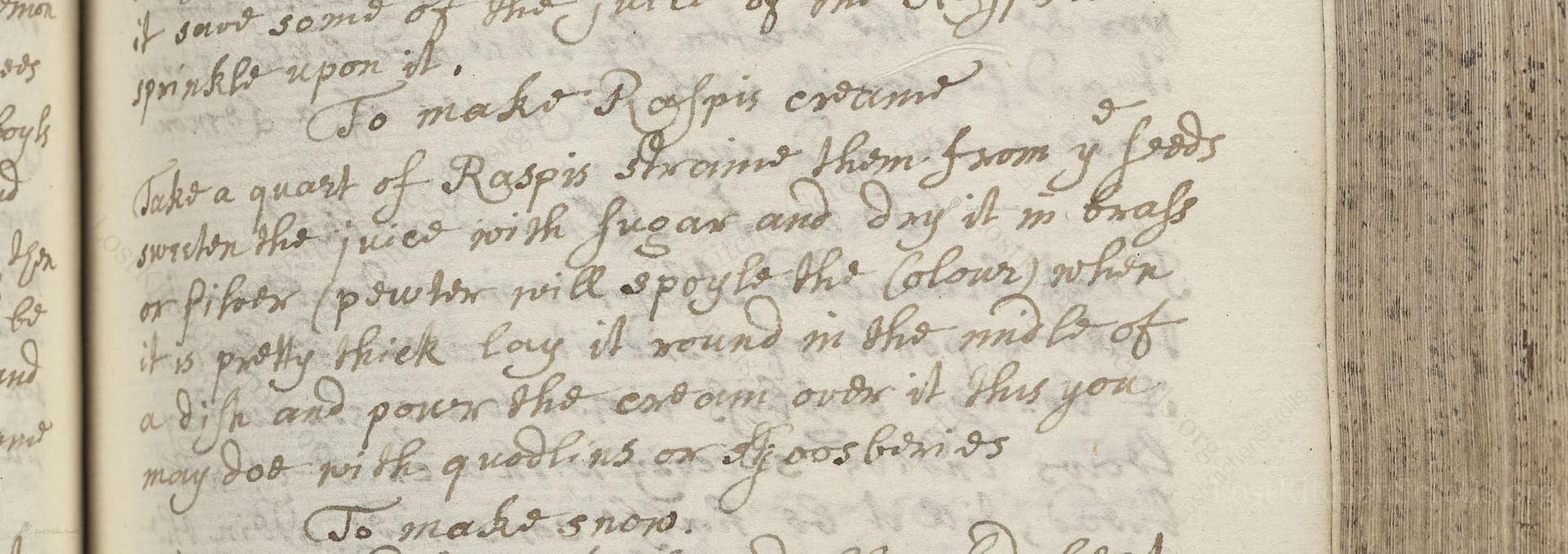To Make Raspis Creame
From the treasured pages of Manuscript cookery book
Unknown Author

To Make Raspis Creame
"Take a quart of Raspis straine them from ye seeds sweeten the juice with sugar and Dry it in baskitts or plates (powder will spoyle the colour) when it is pretty thick lay it round in the bottome of a dish and pour the cream over it. the same you may doe with quoddins or Goosberries."
Note on the Original Text
The recipe is written in the straightforward, economical style of early modern manuscript cookbooks, where measures are approximate and actions assumed to be understood by practiced hands. Words such as 'straine' (for strain), 'baskitts' (baskets), and 'quoddins' (quince) reflect contemporary spelling conventions, which were not standardized at the time. Text emphasizes important details—such as avoiding powdered sugar to keep the vibrant color—showing an early awareness of presentation as well as flavor. Ingredients and instructions are combined in a single paragraph, typical for the era, requiring a confident and experienced reader-cook.

Title
Manuscript cookery book (1680)
You can also click the book image above to peruse the original tome
Writer
Unknown
Era
1680
Publisher
Unknown
Background
A tantalizing window into the kitchens of yesteryear, this late-17th century collection presents recipes and culinary wisdom meant to delight and surprise even the most discerning of historical gourmands.
Kindly made available by
Folger Shakespeare Library
This recipe hails from a manuscript dated approximately 1675 to 1686, a time when home cooks and household managers frequently recorded their favorite or most successful dishes in personal collections. Fruit and dairy combinations were a luxurious treat in this era, as sugar was still considered a valuable commodity, and preserving fruits by drying them was a clever way to enjoy their flavors out of season. The use of 'Raspis'—an archaic spelling for raspberries—demonstrates both culinary creativity and practicality, making the most out of seasonal produce while showcasing the host’s hospitality and skill at the table.

Back in the 17th century, cooks would use wooden or metal sieves for straining fruit, handmade baskets or ceramic plates for drying the sweetened juice, and simple clay or pewter dishes for serving. A warm, airy larder or oven (with a gentle residual heat after baking bread) would serve to slowly thicken and concentrate the sugared fruit juice. Heavy cream would have been skimmed off fresh milk, and the entire dessert assembled just before serving to ensure a lively contrast between tart, concentrated berry and luscious cream.
Prep Time
10 mins
Cook Time
4 hrs
Servings
4
We've done our best to adapt this historical recipe for modern kitchens, but some details may still need refinement. We warmly welcome feedback from fellow cooks and culinary historians — your insights support the entire community!
Ingredients
- 1 quart fresh raspberries (or substitute with blackberries, if preferred)
- 1/2 to 3/4 cup caster sugar (to taste)
- 1 to 1 2/3 cups fresh cream (double or heavy cream)
- Optional: substitute raspberries with gooseberries or quince puree if desired
Instructions
- Begin by taking 1 quart of fresh raspberries and mashing them thoroughly.
- Strain the crushed berries through a fine sieve or cheesecloth to remove the seeds, collecting the vibrant juice.
- Sweeten this juice with caster sugar to your taste, mixing until dissolved—approximately 1/2 to 3/4 cup works well for modern palates.
- Pour the sweetened juice onto shallow dishes or trays (lined with baking parchment works well), and leave it to air dry in a warm, dry place until it thickens considerably, almost like a jam or fruit leather.
- If you’re short on time, you can use a very low oven (around 120°F) with the door open to speed this process up, but avoid using icing or powdered sugar, as the original recipe warns that it discolors the fruit.
- Once thick, arrange the raspberry paste in the bottom of a serving dish in a decorative round, and then pour fresh cream (about 1 to 1 2/3 cups) over the top just before serving.
- This same method works beautifully with quince puree or gooseberries.
Estimated Calories
250 per serving
Cooking Estimates
It takes about 10 minutes to prepare the berries and cream. The drying time can range from 3 to 6 hours, depending on your method. Each serving has about 250 calories, and you can make 4 servings with this recipe.
As noted above, we have made our best effort to translate and adapt this historical recipe for modern kitchens, taking into account ingredients nowadays, cooking techniques, measurements, and so on. However, historical recipes often contain assumptions that require interpretation.
We'd love for anyone to help improve these adaptations. Community contributions are highly welcome. If you have suggestions, corrections, or cooking tips based on your experience with this recipe, please share them below.
Join the Discussion
Rate This Recipe
Dietary Preference

Den Bockfisch In Einer Fleisch Suppen Zu Kochen
This recipe hails from a German manuscript cookbook compiled in 1696, a time whe...

Die Grieß Nudlen Zumachen
This recipe comes from a rather mysterious manuscript cookbook, penned anonymous...

Ein Boudain
This recipe comes from an anonymous German-language manuscript cookbook from 169...

Ein Gesaltzen Citroni
This recipe, dating from 1696, comes from an extensive anonymous German cookbook...
Browse our complete collection of time-honored recipes



